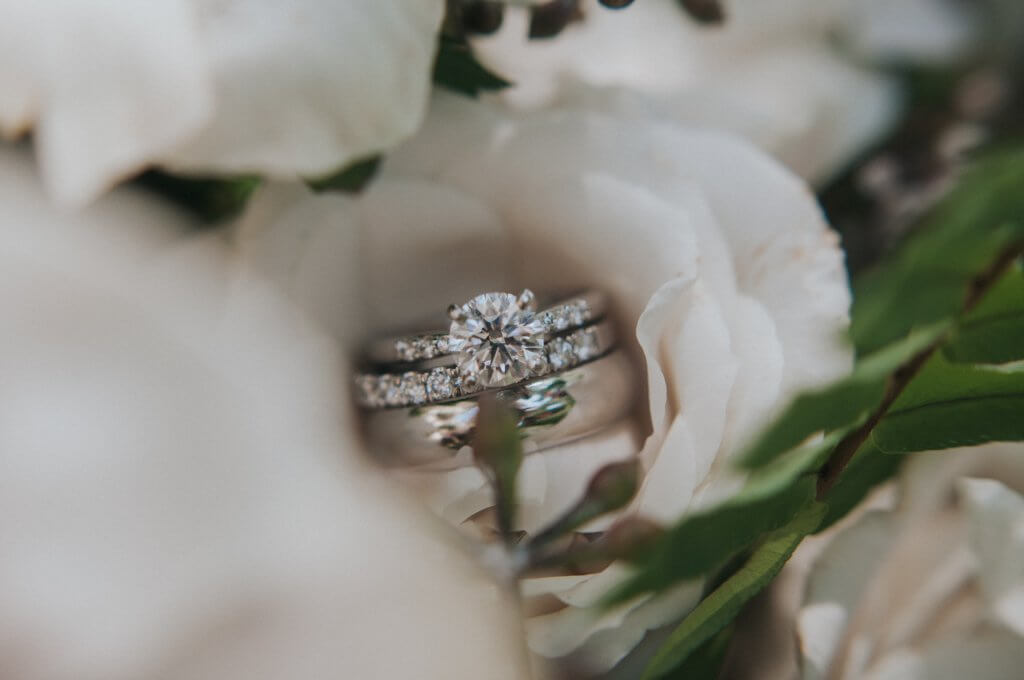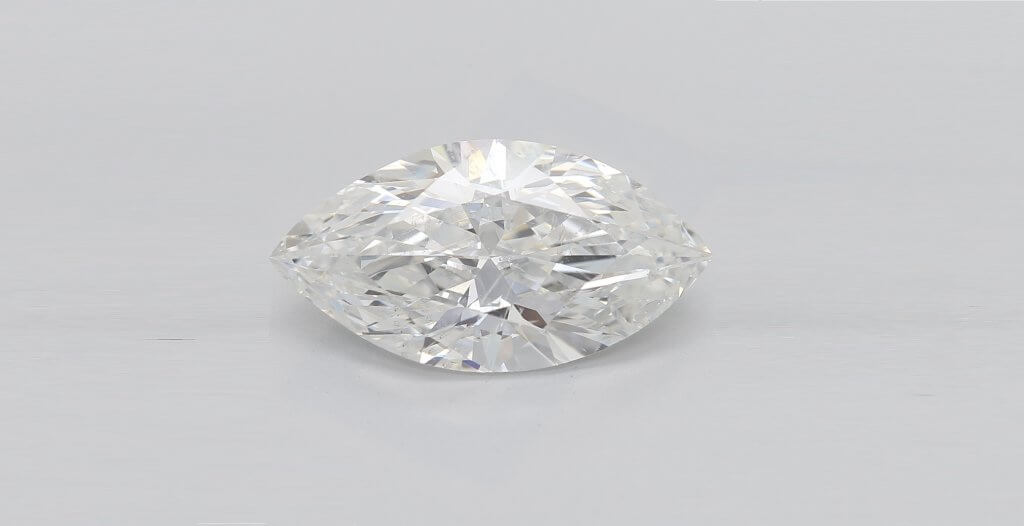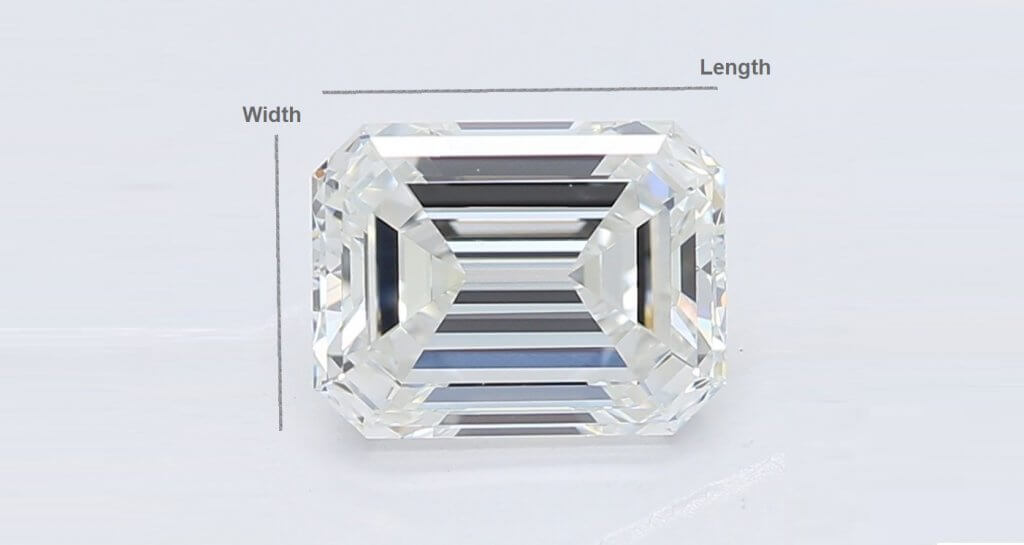Understanding The Importance Of Diamond Depth And Table
Key Takeaways
- A diamond’s depth and table percentages are vital to its ability to produce fire and brilliance.
- A diamond that is too deep or too shallow will fail to produce enough sparkle to live up to expectations. It’ll look too narrow and long (from table to culet), or too wide and stout.
- A diamond that has too small a table or too large a table will also fail to produce sparkle.
- The stone needs to draw in light, but it also needs to direct that light along an ‘optimal path’ in order for sparkle to be created across the upper surface of the stone.
- Understanding the ideal depth and table percentages for your chosen diamond shape is essential.

By now, you likely already know how the Four Cs affect a diamond’s appearance. Namely, how cut impacts sparkle more than any other factor – and, for that reason alone, how important it is to get it right. But what does ‘getting it right’ even mean? For most of us, cut is easily confused with shape – a decision that comes down to personal preference, rather than anything objective or measurable.
Still, as one of the Four Cs, cut is every bit as important as the rest – and, in arguably, more important than any other for those looking to ensure that light will dance across the surface of your ring in a fantastic display of brilliance and fire.
There are multiple factors influencing the strength of a diamond’s cut, from the surface to the mirror-like depths of the stone.
What is Diamond Table and Depth?
The table and depth of a diamond are two separate factors, although they both strongly influence the quality of a diamond’s cut.
The table refers to the uppermost portion of the diamond, while, as the name suggests, a diamond’s depth refers to a very precise measurement made from the table to the culet – or, in other words, its lowest point.
- The Table
- What is the Table on a Diamond?
- Are Bigger Table Diamonds Better?
- What is the Table Percentage of a Diamond?
- What is a Good Table for a Diamond?
- The Depth
- What Does Depth in a Diamond Mean?
- Is Depth Important in a Diamond?
- What Happens When a Diamond is Cut too Deep?
- What is a Good Depth for a Diamond?
- Frequently Asked Questions
- What is the Best Proportion for a Diamond?
- Can a Diamond be too Shallow?
- Why Aren’t All Diamonds Cut to Ideal Proportions?
- Our Summary
The Table
The value of an excellent diamond cut is far greater than the sum of its parts, but it helps to know exactly what these parts are before you make a decision. When you break, say, a Round cut diamond’s cut down, you get the culet, the pavilion, the girdle, the crown and, of course, the table. This table plays a prominent role in sparkle, which means that it pays to know your stuff…
What is the Table on a Diamond?
This is the flat surface at the very top of the diamond. From Round cuts to Emerald, the table will look a little different on every diamond shape, though it plays the same vital role regardless.
More specifically, the table is the largest facet the diamond features – although the precise size of the table varies. Even in diamonds of the same shape, the table size will differ significantly – a factor which will directly impact the quality of the stone’s cut.
Why? Because the table needs to let light into the diamond, while also refracting it into other areas. To accomplish both of these tasks, it must represent a pretty specific percentage of the diamond’s surface area – not an easy task, even for the most skilled of diamond cutters.
How Important is Diamond Table?
The table is an intrinsic part of any diamond. Its job is to allow light into the diamond, to disperse it between the diamond’s many facets, and to reflect it back from the pavilion and out the top of the diamond as brilliance and fire.
If you’re feeling like the diamond table is playing two totally different roles, you’d be right. It’s got to let in light, but also refract light onto the crown, rather than letting it straight back out the table. It’s got to be small enough to do that, but not so small that the diamond looks dull and sparkly.
As a result, getting the proportions of the diamond table right is absolutely vital to creating a good diamond – and it’s not easy. Thankfully, your job is a lot easier, and simply involves getting to know the ‘ideal’ proportions for diamond tables – and knowing the trouble that can be caused by one that is out of proportion, even if it’s just a small amount.
What Happens When the Diamond’s Table is Cut too Small?
The amount of light able to enter the diamond will be reduced, meaning that the diamond will not be able to sparkle as much as it otherwise could, even if it has been given excellent grades for clarity and color.
The beautiful sparkle diamonds are capable of creating depends on the complex pathway light takes through the many facets cut into the surface, and the fascinating internal structure. Of course, it also depends on the diamond’s ability to draw in light in the first place, since diamonds do not ‘create it’ for themselves.
As we mentioned before, the table is the largest facet a diamond has. It sits on the most prominent part of the diamond and, particularly when it has been set within a ring, will be responsible for drawing in most of the light that travels through the stone’s center.
So, an undersized table will fall short of doing its most important job properly, and will limit the amount of light the diamond can transform into sparkle.
Are Bigger Table Diamonds Better?
No, as light will not be refracted into the crown of the diamond as effectively, meaning that the stone’s sparkle will be impaired.
As we mentioned above, the diamond’s table needs to play two roles at once – roles that, for the most part, stand in opposition to one another. If the table comprises too much of the diamond’s upper surface, there will be noticeably less sparkle. Then again, if it comprises too little, the same issue will occur.
In order to be considered ideal, diamond tables need to be above a certain percentage, but below another. This can seem a little confusing, until you get to know the ideal ‘range’ for your chosen diamond shape, and why it’s better to use percentages in the first place.
What is the Table Percentage of a Diamond?
The ratio that exists between the widest point of the diamond, and the width of the table. When it comes to grading a diamond’s cut, a certain percentage range has to be met in order for the diamond to be considered Excellent.
There is no universally ideal measurement for the table. It’s impossible to say that, say, a table with a measurement of 6mm is the best, since this measurement would overwhelm some smaller diamonds, and look far too small on others. So, even if a diamond’s 6mm table turns out to be the perfect size for maximizing sparkle, it will be poor enough to take thousands of dollars off another diamond’s value.
This is why we are given table percentages, since an optimal percentage range will be pretty much the same whether you’re looking at a one carat diamond or a ten carat diamond (provided, of course, that they’re the same cut.

What is a Good Table for a Diamond?
For the traditional Round cut diamond, a table of between 56% and 59.9% is considered Excellent, while anything below 49.9 is Poor. Other cuts differ somewhat – and, in many cases, offer a little more leeway than the Round diamond when it comes to table percentage.
For instance, the ideal table percentage for square diamonds is much broader. The Radiant cut features an ‘Excellent’ table percentage of between 61% and 69.9%, while the Asscher offers a range of 60% to 65.9%.
Below, we’ve included a table of ‘Excellent’ and ‘Very Good’ table percentages for all of the most popular diamond shapes.
| Shape | ‘Excellent’ Table % Range | ‘Very Good’ Table % Range |
| Asscher | 60% – 65.9% | 58% – 59.9% or 66% – 69.9% |
| Cushion (Square and Rectangle) | 60% – 65.9% | 58% – 59.9% or 66% – 69.9% |
| Emerald | 60% – 65.9% | 58% – 59.9% or 66% – 72.9% |
| Marquise | 53% – 65.9% | 52% – 52.9% or 63% – 65.9% |
| Oval | 55% – 62.9% | 52% – 54.9% or 63% – 65.9% |
| Pear | 53% – 62.9% | 52% – 52.9% or 63% – 65.9% |
| Princess | 67% – 72.9% | 60% – 66.9% or 73% – 75.9% |
| Radiant (Square) | 61% – 69.9% | 57% – 60.9% or 70% – 72.9% |
| Radiant (Rectangle) | 60% – 66.9% | 58% – 59.9% or 67% – 70.9% |
| Round | 56% – 59.9% | 54% – 55.9% or 60% – 60.9% |
For anyone looking to buy a beautiful ring, of any size or shape, to set within an engagement ring (or any jewelry, for that matter), it is never advisable to go below an Excellent or Very Good cut grade.
Diamonds featuring a table that exceeds the shape’s ideal percentage range will have limited fire, while those that feature
The Depth
While a good size of table is vital to a diamond’s ability to produce plenty of fire and brilliance, that’s not the only factor diamond cutters, jewelers or, for that matter, you need to consider in order to get the best possible diamond for your money.
What Does Depth in a Diamond Mean?
Put simply, depth refers to the distance from the diamond’s table to its lowest point. Like the table, depth is most commonly conveyed as a percentage, rather than a measurement.
Why? Because, just as before, there is no ideal measurement for depth – although there is an ideal ratio, or percentage.
This percentage is reached by dividing the height of the diamond by the width, and will once again determine whether it is Excellent, Very Good, Good, Fair or Poor. Again, you want to aim for Excellent or Very Good, or risk a diamond with impaired light performance.
Is Depth Important in a Diamond?
Yes, it is key to ensuring that the diamond’s cut is
When we think of diamonds – and, more specifically, diamond engagement rings – it is much more common for us to picture that birds’ eye view. We imagine ourselves looking down on the table and crown of the diamond since, when it is worn on the finger, this is the part that will be most prominent.
It is important to remember, however, that every part of the diamond influences that light performance you seen dancing across the surface. In other words, a beautiful sparkle is only made possible by an all-round beautiful diamond.
What Happens When a Diamond is Cut too Deep?
A diamond with less-than-ideal proportions will have a dulled sparkle, due to the fact that light is being refracted and lost through the pavilion (the bottom portion of the diamond), rather than the table.
This is similar to what happens when a diamond is cut too shallow. While the path light takes through a deep cut diamond will be totally different to the path light takes through a shallow cut diamond, the end result is pretty much the same – and just as undesirable in either case.
If light is lost through the pavilion rather than the table, then that all-important birds’ eye view will be what suffers the most. Looking down on the diamond, you will see less sparkle, and a diamond lacking the liveliness and shine of better proportioned stones, even if they feature the same shape and carat weight.
What is a Good Depth for a Diamond?
There is no definitive answer to this question, although, as with the table percentage, there is an ideal depth percentage range into which any good diamond will fall.
The diamonds used in the center settings of engagement rings differ drastically in size, from below one carat to well over twenty – although not all of us can carry off Beyoncé’s 24 carat Emerald cut diamond. What this means is that there is no ‘recommended depth measurement’ out there that could apply to all diamonds, despite the fact that countless beautiful diamonds are cut and graded each year.
Similarly, no single measurement (or percentage) could apply to all of the diamond shapes out there, since each one boasts different proportions, and varying numbers of facets.
So, just as before, here are the ‘Excellent’ and ‘Very Good’ depth percentages for diamonds.
| Shape | ‘Excellent’ Depth % Range | ‘Very Good’ Depth % Range |
| Asscher | 63% – 67.9% | 58% – 62.9% or 68% – 69.9% |
| Cushion (Square and Rectangle) | 63 – 67.9 | 58% – 62.9% or 68% – 69.9% |
| Emerald | 63% – 67.9% | 59% – 62.9% or 68% – 69.9% |
| Marquise | 58% – 62.9% | 56% – 57.9% or 63% – 65.9% |
| Oval | 58% – 62.9% | 56% – 57.9% or 63% – 65.9% |
| Pear | 67% – 72.9% | 64% – 66.9% or 73% – 74.9% |
| Princess | 67% – 72.9% | 64% – 66.9% or 73% – 74.9% |
| Radiant (Square) | 61% – 67.9% | 59% – 60.9 % or 68% – 69.9% |
| Radiant (Rectangle) | 63% – 67.9% | 59% – 62.9 % or 68% – 69.9% |
| Round | 59% – 62.3% | 58% – 58.9% or 62.4% – 63.5% |
Frequently Asked Questions
What is the Best Proportion for Diamond?
The ideal proportions for any diamond will vary drastically depending on its shape and size.
The right diamond for you will be one that falls within the ‘Excellent’ or ‘Very Good’ grades for table percentage, depth percentage, diamond symmetry, length to width ratio, culet, and girdle. The conditions for meeting these grades depends on the diamond’s shape, so check out our guide to ideal cut diamond proportions before you head out to the jewelry store.
Why Aren’t All Diamonds Cut to Ideal Proportions?
Because, most of the time, diamond cutters have to choose between cutting the biggest diamond possible out of the rough stone, and benefitting from the high value large diamonds have on the market, and cutting an ideal proportioned diamond which, while ideal for engagement rings, will likely be smaller.
For some shoppers who have not yet done their research on diamonds, the most important feature of any diamond is size. It’s understandable why. Afterall, brides-to-be aren’t quizzed on the proportions of their diamond.
And, while plenty of savvy shoppers will eventually brush up on their diamond knowledge, there is still a market out there for big diamonds – even those that are out of proportion.
Similarly, some rough stones will feature a major inclusion that could totally undermine the value of a diamond. In order to cut around that inclusion, they might have to cut the diamond to the wrong proportions.
It can be confusing but, provided you remember that ideal proportions mean better brilliance, fire, and scintillation, you’ll know which side of the fence you fall onto.
Our Summary: Are Diamond Depth and Table Important?
Yes, diamond depth and table are two of the most significant factors behind the quality of the diamond’s cut, and, as a result, its sparkle.
Cut is crucial – it’s the deciding factor behind whether or not a diamond is worth your time or not. And, while cut comprises far more features than just depth and table, there really is no room for error when it comes to these two percentages.
It’s easy enough to tell yourself that a deep or shallow diamond won’t look too deep or too shallow once its set within the ring, or that a smaller table adds to the unique ‘charm’ of the diamond, but that’s why it’s so important to understand how these two features will impact the stone’s light performance, and why you should never compromise on that.

Aug 1, 2022 By Willyou.net
The Truth About Shallow Cut Diamonds

Sep 18, 2021 By Willyou.net
This Diamond Cut Outsparkle The Rest – An Insider’S Guide








